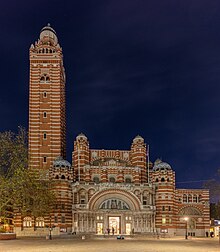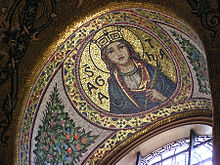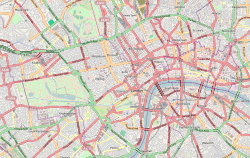
Back كاتدرائيه وستمنستر ARZ Вэстмінстэрскі сабор BE Catedral de Westminster Catalan Westminsterská katedrála Czech Westminster Cathedral Danish Westminster Cathedral German Katedralo de Westminster EO Catedral de Westminster Spanish Westminster katedrala EU کلیسای جامع وستمینستر FA
| Metropolitan Cathedral of the Most Precious Blood Westminster Cathedral | |
|---|---|
 Frontal view as seen from Victoria Street | |
| 51°29′46″N 0°08′23″W / 51.4961°N 0.1397°W | |
| OS grid reference | TQ 29248 79074 |
| Location | Francis Street, Westminster London, SW1 |
| Country | England |
| Denomination | Roman Catholic |
| Website | westminstercathedral |
| History | |
| Status | Cathedral |
| Dedication | Most Precious Blood |
| Consecrated | 1910 |
| Architecture | |
| Architect(s) | John Francis Bentley |
| Style | Neo-Byzantine |
| Years built | 1895–1903 |
| Specifications | |
| Length | 110m (360ft) |
| Width | 47m (156ft) |
| Number of towers | 1 |
| Tower height | 87m (284ft), including the cross |
| Administration | |
| Province | Westminster |
| Diocese | Westminster (since 1884) |
| Clergy | |
| Archbishop | Vincent Nichols |
| Dean | Slawomir Witon |
| Laity | |
| Organist(s) | Simon Johnson, Peter Stevens |
Listed Building – Grade I | |
| Designated | 1 December 1987 Amended 15 February 1994 |
| Reference no. | 1066500[1] |
| Part of a series on the |
| Catholic Church in England and Wales |
|---|
 |
| Organisation |
| History |
| Associations |
|
|









The Metropolitan Cathedral of the Most Precious Blood, informally known as Westminster Cathedral, is the largest Roman Catholic church in England and Wales. The shrine is dedicated to the Blood of Jesus Christ and is the seat of the Archbishop of Westminster.
The original site on which the cathedral stands in the City of Westminster was purchased by the Diocese of Westminster in 1885, and construction was completed in 1903.[2] Designed by John Francis Bentley in a 9th-century Christian neo-Byzantine style, and accordingly made almost entirely of brick, without steel reinforcements,[3][4] Sir John Betjeman called it "a masterpiece in striped brick and stone" that shows "the good craftsman has no need of steel or concrete."[5]
The cathedral merited an Apostolic Visit from Pope John Paul II on 28 May 1982 and Pope Benedict XVI in 18 September 2010.
- ^ Historic England. "Wesminster Cathedral (1066500)". National Heritage List for England. Retrieved 10 November 2016.
- ^ "Westminster Cathedral – London, England". www.sacred-destinations.com. Retrieved 12 November 2019.
- ^ Mark Daly (16 October 2018). London Uncovered (New Edition): More than Sixty Unusual Places to Explore. White Lion Publishing. p. 134. ISBN 978-0-7112-3998-2.
- ^ Lance Day; Ian McNeil (11 September 2002). Biographical Dictionary of the History of Technology. Routledge. p. 111. ISBN 978-1-134-65019-4.
- ^ Betjeman, John (25 July 1974). A Pictorial History of English Architecture. Penguin Books Ltd. p. 95. ISBN 978-0140038248.
